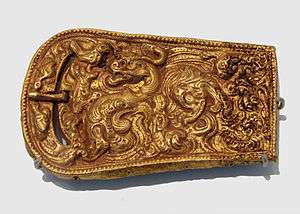Belt hook

The belt hook is a device for fastening that predates the belt buckle.[1][2]
The earliest archaeological evidence of belt hooks date to the 7th century BC, in East Asia.[1] Belt hooks were made with bronze, iron, gold, and jade.[1] Texts from Warring States period China claim that the belt hook originates from Central Asian nomads, although belt hooks have been found in China predating the Warring States.[2] The equestrian tradition, initially foreign to China, was tightly related to wearing belted pants, thus belt hooks became one of the features of "barbaric" exoticism. As such, the hooks became an object of aesthetic contemplation. For example, Qu Yuan (ca.340-278 BCE) compares beautiful women to the belt hooks xianbei 鮮卑.[3]
Belt hooks have also been found in Celtic archaeological sites.[4]

References
- 1 2 3 Barbara Ann Kipfer (30 April 2000). Encyclopedic Dictionary of Archaeology. Springer. p. 64. ISBN 978-0-306-46158-3.
- 1 2 Donald B. Wagner (1993). Iron and Steel in Ancient China. BRILL. p. 169. ISBN 978-90-04-09632-5.
- ↑ "Kinesis versus Stasis, Interaction versus Independent Invention" by Victor H. Mair in Contact and Exchange in the Ancient World, University of Hawai‘i Press, 2006:1-2. (retrieved 27.02.2015)
- ↑ D. W. Harding (18 June 2007). ARCHAEOLOGY OF CELTIC ART. Psychology Press. p. 124. ISBN 978-0-415-35177-5.